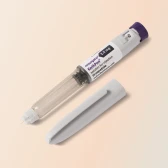Before there were injector pens like Mounjaro and Wegovy, pills were the mainstay of weight loss medication. In fact, diet and weight loss pills have been around for decades—though today, it’s mostly just one (orlistat) that’s prescribed in the UK.
We can understand that taking a pill might seem easier and more convenient than an injection (though, we must say, the pens are pretty straightforward to use). Yet the injections can drive serious results: for instance, people taking Mounjaro could lose up to 22.5% of their starting weight—and people taking 7.2mg of Wegovy lost 20.7% in a clinical trial.
So, which medicine should you go for: injector pens or pills? Because everyone’s different, we can’t say for sure how a particular medicine might affect you personally. But we can weigh up the pros and cons of different options—and dig into the scientific research to get a steer on which may be more effective. We’ve laid it all out for you below.
Which weight loss injections and pills are available in the UK?
Here are the most commonly-prescribed weight loss injections and pills in the UK. And FYI: all of them are meant to be taken alongside healthy lifestyle changes.
Weight loss injections
These work by making you feel full, so you eat less. We’ve explained how they do that in more detail further down the page.
Mounjaro
Using the active ingredient tirzepatide, Mounjaro works by behaving like two natural hormones: GLP-1 and GIP. This dual action is what makes it so potent.
Wegovy
Wegovy only mimics the effects of GLP-1 (this type of medicine is called a GLP-1 receptor agonist). That means it brings on the effects of one hormone, rather than two like Mounjaro. Its active ingredient is semaglutide.
Saxenda
And then we have Saxenda, another GLP-1 receptor agonist. Though it uses a different active ingredient than Wegovy—liraglutide.
For a detailed comparison of Wegovy and Saxenda, see our guide.
(And if you’re curious about new injectables coming soon, you might want to read about Survodutide, a GLP-1/glucagon receptor agonist still in trials, as well as CagriSema, which combines semaglutide and cagrilintide for even greater appetite control.)
Weight Loss Pills
Orlistat
This is the only weight loss pill you can get on the NHS, and the only one we offer as part of our weight loss programme. It works by reducing the amount of fat you absorb from your food.
Rybelsus
While not yet approved for weight loss in the UK, Rybelsus is another pill option containing semaglutide, the same active ingredient as Wegovy. Unlike orlistat, this medication works by suppressing appetite like GLP-1 injections.
How do weight loss injections work?
We’re glad you asked. Weight loss injections make you feel full by acting like hormones that are released when you eat: either just GLP-1 (Wegovy and Saxenda) or GLP-1 and GIP (Mounjaro). That means they bring on the same effects that those hormones naturally would in the body.
To be more specific they stimulate the production of insulin after you eat (which tells the brain you’re full), tell the brain to lower your appetite, and slow the rate of digestion (this makes you feel fuller for longer).
Mounjaro does the above via the effects of two hormones rather than one.
Orlistat takes another approach entirely—it prevents your gut from absorbing fat from your diet. This fat then comes out in your stools.
Pros and cons of weight loss injections vs pills
Okay, now let’s get into the nitty gritty: how do weight loss pills stack up against injections?
Effectiveness
Per scientific research, injections come out on top here. On average, studies have shown that:
- People taking Mounjaro lost around 22.5% body weight after 88 weeks.
- People taking Wegovy lost around 15% body weight on average after 68 weeks. And new research looking at people taking a higher dose—7.2mg—shows a mean weight loss of 20.7% after 72 weeks.
- After a year on Saxenda, people lost 7.4% body weight on average.
- Roughly one in five people on orlistat lost at least 10% body weight after a year
And for reference: lifestyle changes alone can lead to around 1-10% weight loss.
Ease of use
Because pills are taken orally, you might see them as more convenient than an injection. Though injector pens are pretty simple to use, and for most people, the pain is either very mild or non-existent.
Aside from Saxenda, which is taken every day, weight loss injections are done weekly. But you need to take pills at least once per day: you can take orlistat up to three times a day, but only when you consume a fat-containing meal.
Side effects
Side effects are common for any of the medicines we’ve mentioned and can affect over one in ten people. Mostly though, they’re manageable and clear up on their own.
Symptoms from injections tend to affect the gut: think nausea, vomiting, diarrhoea, and constipation. If you’re taking Mounjaro, here’s a breakdown of its side effects.
With orlistat, the most common symptoms include headache, abdominal pain, and passing oily stools more frequently.
Heads up: this isn’t a full list of all possible side effects. And if your symptoms get worse, are bothering you, or don’t go away, check in with your clinician.
Side effects support at Voy
"If you're using Voy and you experience any side effects, rest assured that our expert clinicians are just a message or phone call away. They can adjust your dose, prescribe medication to ease your symptoms, or simply offer reassurance.
Everyone responds differently to weight loss treatment and we'll help you find what feels right for you."

Cost
Pills are the winner here. While prices can vary depending on the provider, a pack of Orlistat is generally cheaper than injectable weight management solutions.
Choosing the right weight loss medication for you
What’s right for you depends on your personal preferences and health goals. For those with PCOS, weight loss can be more effective with medications that also improve insulin sensitivity.
If a less potent medicine can get you results you’re happy with, that’s totally fine too. Though ultimately, your provider will recommend what they think is best.
Whatever you go for, it’s super important that you use your medication alongside a nutritious, balanced diet and regular exercise. That’s how all of these medicines are meant to be taken and they might not work as well if you use them on their own.
They aren’t a quick fix or shortcut to reaching your goals, either. To get the most out of weight loss medication, you usually need to take it for at least a year. We know that sounds like a long time, but we know you’ve got this.
Your weight loss journey
With so many options, we get that you might be feeling a little overwhelmed right now! And while it can be scary to take a leap and try a new medicine, we want to remind you that you aren’t on this journey alone.
As part of our weight loss programme, you’ll get weekly medication (we have Mounjaro, Wegovy, Saxenda, and Orlistat) plus one-to-one access to our team of coaches and clinicians who will create a personalised plan of action for you. We’re in this with you for the long haul: from your first step to the moment you smash your goals—and beyond.
Interested in weight management medication? Take a couple of minutes to fill out this short form to see if you’re eligible.
Arrone, Louis J, et al. “Continued Treatment with Tirzepatide for Maintenance of Weight Reduction in Adults with Obesity.” JAMA
“Dietary Advice for Patients Taking Orlistat: Patient Information.” University Hospitals Coventry and Warwickshire NHS Trust. 
Jastreboff, Ania M, et al. “Tirzepatide Once Weekly for the Treatment of Obesity.” The New England Journal of Medicine
“Mysimba.” European Medicines Agency. (2015). Accessed 7 Jan. 2025. www.ema.europa.eu/en/documents/overview/mysimba-epar-summary-public_en.pdf.
National Institute for Health and Care Excellence. “Liraglutide for Managing Overweight and Obesity.” Nice.org.uk 

National Institute for Health and Care Excellence. “Semaglutide for Managing Overweight and Obesity.” Nice.org.uk 
National Institute for Health and Care Excellence. “Tirzepatide for Managing Overweight and Obesity.” Nice.org.uk 
Olateju, Iyanu V, et al. “A Systematic Review on the Effectiveness of Diet and Exercise in the Management of Obesity.” Diabetes & Metabolic Syndrome: Clinical Research & Reviews
Papakonstantinou, Ilias, et al. “Spotlight on the Mechanism of Action of Semaglutide.” Current Issues in Molecular Biology,
Rodriguez, Patricia J, et al. “Semaglutide vs Tirzepatide for Weight Loss in Adults with Overweight or Obesity.” JAMA Internal Medicine
“Saxenda: Full Prescribing Information.” Food and Drug Administration. 
Snitker, Søren, et al. “Comparison of the Injection-site Experience of the Starting Doses with Semaglutide and Dulaglutide: A Randomised, Double-blind Trial in Healthy Subjects.” Diabetes, Obesity and Metabolism
“Tirzepatide.” British National Formulary. 
Wilding, John P.H., et al. “Once-weekly Semaglutide in Adults with Overweight or Obesity.” The New England Journal of Medicine
Willard, Francis S, et al. “Tirzepatide is an Imbalanced and Biased dual GIP and GLP-1 Receptor Agonist”. JCI Insight
“Xenical (orlistat). Prescribing Information.” Food and Drug Administration.
“Xenical 120mg (Orlistat). Package Leaflet: Information for the User.” Electronic Medicines Compendium.
Xie, Zeyu, et al. “Efficacy and Safety of Liraglutide and Semaglutide on Weight Loss in People with Obesity or Overweight: A Systematic Review.” Clinical Epidemiology










